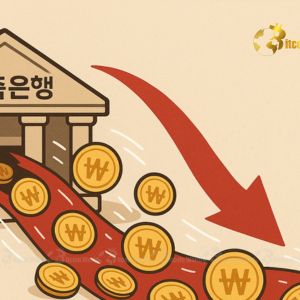Bank of Korea Issues Crucial Warning on Non-Bank Won Stablecoins
6 min read
Are you tracking the evolving landscape of digital currencies? The world of finance is abuzz with discussions around stablecoins and central bank digital currencies (CBDCs). In a significant development, the Bank of Korea has voiced strong concerns regarding the issuance of won stablecoins by non-banking entities. This stance sends a clear signal about the nation’s cautious approach to digital currency innovation, prioritizing financial stability and consumer protection. Understanding Won Stablecoins and Central Bank Digital Currency (CBDC) The rise of digital assets has brought forth new forms of currency, notably stablecoins. Unlike volatile cryptocurrencies like Bitcoin or Ethereum, stablecoins aim to maintain a stable value by pegging themselves to a reserve asset, often a fiat currency like the US dollar or the Korean Won. A won stablecoin , for instance, would be designed to hold a value equivalent to one Korean Won, typically backed by reserves of the same currency held by an issuer. However, the concept of a stablecoin issued by a private, non-banking entity raises distinct questions when compared to a Central Bank Digital Currency (CBDC) . While both are digital representations of a national currency, their underlying structure, regulatory oversight, and implications for the broader financial system differ fundamentally. The Bank of Korea , through its Governor Rhee Chang-yong, highlights this crucial distinction. What’s the Core Difference? Issuer: Private stablecoins are issued by companies, sometimes outside traditional financial regulation. CBDCs are issued directly by the central bank. Backing: Private stablecoins rely on reserves held by the issuer, which may or may not be fully transparent or audited. CBDCs are direct liabilities of the central bank, carrying sovereign backing. Purpose: Private stablecoins often aim for faster, cheaper transactions and broader crypto ecosystem integration. CBDCs aim to modernize payment systems, enhance financial inclusion, and maintain monetary policy control. Why is the Bank of Korea Concerned About Non-Bank Won Stablecoins? Governor Rhee Chang-yong’s statement isn’t merely a cautionary note; it reflects deep-seated concerns shared by central banks globally regarding the potential risks posed by privately issued stablecoins, especially when they reach systemic importance. The problems he alludes to are multi-faceted, touching upon the very pillars of a nation’s economic health and its citizens’ financial well-being. Potential Pitfalls of Private Stablecoin Issuance: Threats to Financial Stability: Imagine a large-scale private stablecoin issuer facing a liquidity crisis or a ‘run’ on its reserves. This could trigger panic, leading to widespread redemptions and potentially destabilizing the broader financial system, much like a bank run. Without robust regulatory frameworks and oversight, such an event could have ripple effects across markets. Erosion of Monetary Policy Control: If a significant portion of transactions and savings migrate from traditional bank deposits to privately issued stablecoins, the central bank’s ability to influence interest rates, manage money supply, and conduct effective monetary policy could be severely hampered. This loss of control could undermine efforts to manage inflation or stimulate economic growth. Consumer Protection Risks: Unlike bank deposits, privately issued stablecoins typically lack the safety nets of deposit insurance schemes. If an issuer becomes insolvent, consumers could lose their funds. Furthermore, issues around transparency of reserves, operational resilience, and cybersecurity could expose users to significant risks. Challenges in Combating Illicit Finance: The decentralized nature and pseudonymous aspects of some stablecoin operations could make them attractive for money laundering, terrorist financing, and other illicit activities. Central banks and regulators face an uphill battle in enforcing Anti-Money Laundering (AML) and Counter-Terrorist Financing (CTF) measures effectively without proper oversight. The Bank of Korea ‘s apprehension stems from a commitment to safeguarding the integrity and stability of the national currency and payment system. This is where the concept of a CBDC becomes paramount as a secure, reliable alternative. The Han River Project: Korea’s Path to a Secure Digital Currency In response to the evolving digital landscape and to address the very concerns raised about private stablecoins, the Bank of Korea has been actively pursuing its central bank digital currency initiative, known as the ‘Han River Project’. This project is not merely an experiment; it’s a strategic undertaking aimed at laying the groundwork for a future digital won that is both innovative and secure. Key Aspects of the Han River Project: Foundational Infrastructure: The project is designed to build a robust and resilient digital currency infrastructure that can support future financial innovations while ensuring stability. Security and Reliability: By issuing the digital won directly, the BOK aims to provide the highest level of security and reliability, backed by the full faith and credit of the central bank. This contrasts sharply with the potential risks associated with private stablecoin issuers. Phased Approach: The Han River Project has involved various phases, including technical feasibility studies, pilot programs, and simulations to test the practical applications and implications of a CBDC in a real-world scenario. Innovation Catalyst: While focused on stability, the CBDC is also viewed as a potential catalyst for innovation in payment systems, enabling new services and efficiencies within the financial sector. Governor Rhee’s statement underscores that the Han River Project is the ‘first step toward introducing secure and reliable won-based stablecoins.’ This implies that while private stablecoins are viewed with caution, the BOK acknowledges the demand for digital won-based instruments and seeks to fulfill this demand through a centrally controlled, secure mechanism. Global Implications for Digital Currency and Regulation The Bank of Korea ‘s stance is not isolated; it mirrors a growing trend among central banks worldwide grappling with the challenges and opportunities presented by digital currencies. From the European Central Bank’s exploration of a digital euro to China’s advanced digital yuan project, central banks are actively researching and developing their own CBDCs as a response to the digital revolution and as a means to maintain control over their monetary systems. A Global Balancing Act: Regulators globally are walking a tightrope between fostering innovation in the digital asset space and mitigating systemic risks. The debate often revolves around: Regulation vs. Prohibition: Should private stablecoins be banned, or can they be brought under a robust regulatory umbrella similar to traditional financial institutions? Interoperability: How can CBDCs and regulated private digital assets coexist and interact seamlessly within the broader financial ecosystem? Cross-Border Payments: Can CBDCs facilitate more efficient and secure international transactions, potentially reducing reliance on traditional correspondent banking? The Korean perspective adds another layer to this global dialogue, emphasizing the central bank’s role as the ultimate guarantor of financial stability in the digital era. What Does This Mean for the Future of Won Stablecoins and the Crypto Market? Governor Rhee’s remarks signal a clear direction for the future of won stablecoins in Korea. It’s highly probable that non-bank entities issuing such stablecoins will face significant regulatory hurdles, if not outright restrictions, in the coming years. The emphasis will likely shift towards central bank-issued digital won as the preferred and most secure form of digital national currency. Actionable Insights: For Crypto Businesses: Companies operating with won-pegged tokens should closely monitor BOK’s regulatory developments. The focus might shift towards integrating with future CBDC infrastructure rather than relying on privately issued stablecoins. For Investors: Be aware of the regulatory risks associated with privately issued stablecoins, especially those lacking clear oversight. The ‘secure and reliable’ label will increasingly apply to central bank-backed digital assets. For Policymakers: The BOK’s stance provides a case study for balancing innovation with risk management, highlighting the importance of a clear regulatory perimeter for all forms of digital currency . The trajectory seems clear: the Bank of Korea is committed to ensuring that any digital form of the won maintains the same level of trust, security, and stability as its physical counterpart, with the CBDC being the primary vehicle for achieving this goal. Concluding Thoughts: Navigating Korea’s Digital Currency Future The Bank of Korea’s strong position on non-bank issued won stablecoins underscores a global imperative: as the financial world digitizes, central banks are asserting their role as guardians of monetary sovereignty and financial stability . While private innovation is valued, the risks associated with unregulated digital currencies, particularly those purporting to be stable, are too significant to ignore. The Han River Project represents a proactive and pragmatic approach by the Bank of Korea to embrace digital transformation on its own terms, ensuring that the transition to a digital economy is secure, inclusive, and resilient. This stance will undoubtedly shape the landscape for digital assets in Korea, setting a precedent for how a major economy approaches the delicate balance between innovation and regulation in the age of digital money. To learn more about the latest digital currency trends and regulatory developments, explore our articles on key developments shaping the future of financial stability in the digital age.

Source: Bitcoin World



